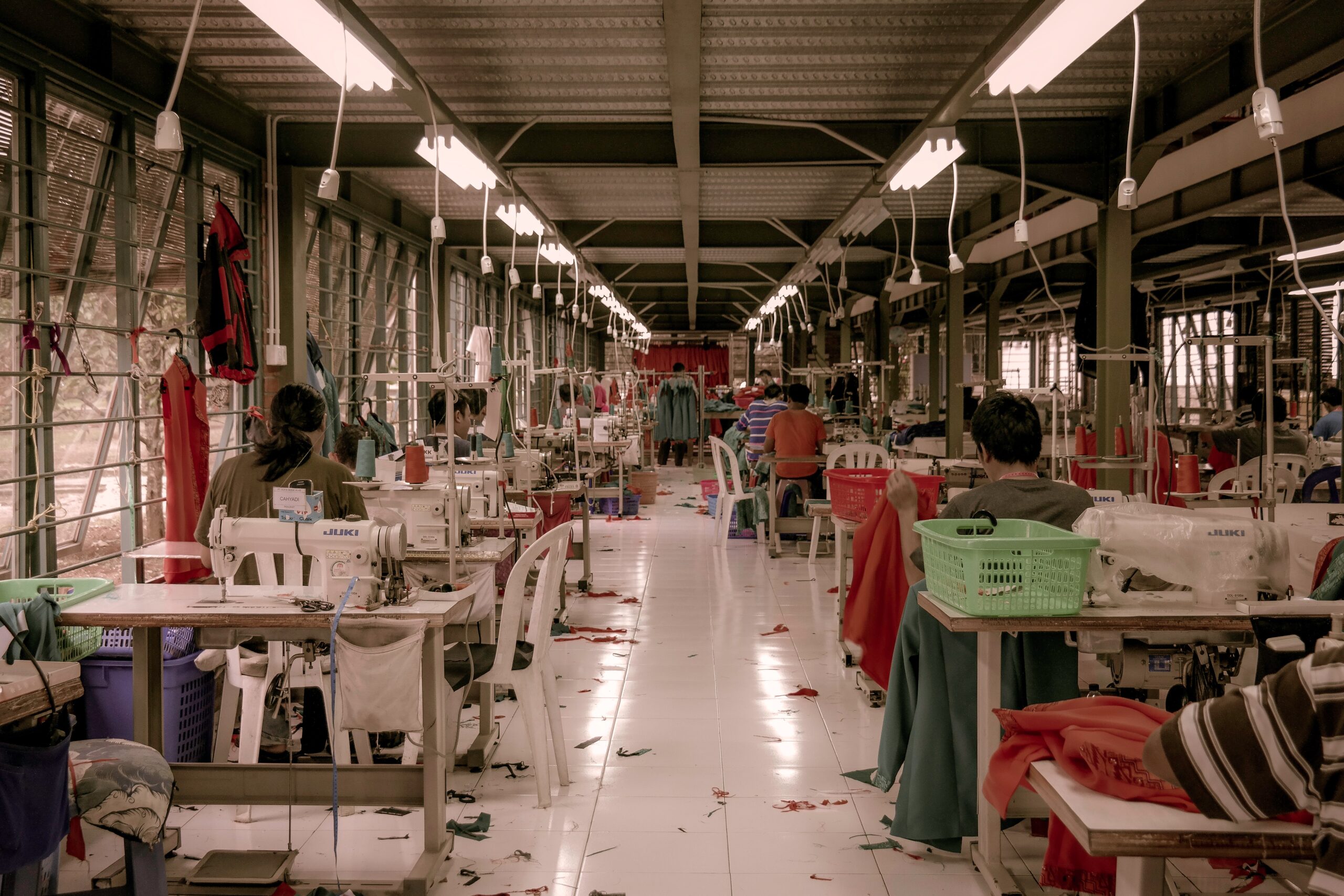By Kasi Martin and Meera Reval
Travel to Kantamanto Market in Accra, Ghana, the largest second-hand clothing market in West Africa, and you’ll find a community brimming with creative energy.
Creativity is their way to overcome the consumption that’s been forced upon them as the west ships hoards of castoff clothing for them to sort, upcycle, and sell.
The Kantamanto Market recently made waves when SheIn donated a laughable amount of its profits to the Or Foundation to “help” the community manage the onslaught of clothing. But this issue of shipping castoffs to developing nations is not new.
I first read about it in The Travels of a T-shirt in a Global Economy, when the economist and author Pietra Rivoli took a counter-stance that shipping castoffs to the Tanzanian city, Dar es Salaam, created a vibrant new “mitumba” industry. In the mitumba trade, Rivoli reported, sophisticated buyers and sellers thrived in the marketplace when they matched the right piece, what is called a “snowflake”, to the right buyer.
Today, it’s hard to find people like Rivoli who praise the global rag trade. (Other than U.S. business owners). And while castoffs have been a major sticking point in the recent arguments against globalization, I’m also speaking about production and manufacturing in other countries.
That’s why we wrote this piece. To weigh the pros and cons of the global apparel trade and re-examine the question, Should fashion still be global? through a modern, post-pandemic lens.
Here’s Meera to take it away:
What is globalization in apparel?
Before we jump in, let’s broadly define it. Globalization is a term that has gained prominence in the last decade across every industry and geographic location. It made the movement of goods, people, and capital accessible across far locations. Most often, globalization also means that dominant cultures and markets (i.e. western) supersede local markets and less dominant cultures (i.e. low income).
In the apparel industry, mass-market brands and retailers have benefitted from the competitive pricing and open access globalization offered. Globalization made the industry more receptive to different styles, cultural influences, and production techniques–giving people worldwide access to a broader range of apparel.
In the past few decades, there has been a significant shift in the geographical distribution of the textile, apparel, and footwear sectors’ production, leading to substantial employment losses in North America and Europe and significant gains in Asia and other developing regions. At present, more than 60 percent of world clothing exports are manufactured in developing countries (ILO).
In many countries, this trend was followed by production moving from the formal to the informal sector (need or piece-based vs. formally employed), which has negatively impacted wage levels and working conditions for garment workers. For example, the legal minimum wage for a Bangladesh garment worker is $96 USD a month, barely hovering above the homeless line. In reality, wages may be much lower than this if workers are not formally employed.
Conversely, the ILO also found that globalization has increased job opportunities worldwide and that the informal sector promotes “a growing volume of employment in developing countries, especially in clothing and footwear”.
The benefits of apparel globalization
Access to materials and merchandise
Fashion is a creative industry that relies heavily on international collaboration and trends. Importing can allow businesses in one country to give their customers access to fashion from another country that they may have never seen before. It’s also necessary in some cases to gain access to technologies or fibers that aren’t produced locally (like hemp in China or sophisticated watch design). For responsible brands, sourcing globally can be a necessity because manufacturing capabilities in the states are dated or nonexistent.
Globalization also gives artisans and other cultures exposure to new markets and customers. Similarly, producers can use importing to find new raw materials needed to create unique works that would be impossible to create domestically. In sum, it broadens the boundaries of ideas and aesthetics, allowing them to flourish beyond their region and capture new peoples’ attention.
Reducing cost for businesses
One of the primary reasons companies source globally is to control costs. So, to be clear, this benefit is often just for the business employing the cost-cutting strategy. Employing foreign workers and importing finished goods, for example, is frequently less expensive than producing raw materials locally and employing domestic labor. Contracting with foreign suppliers and fabricators reduces payroll and material costs, allowing for higher profits and lower wholesale prices. It also gives fashion retailers more room to drive customer demand through competitive pricing. While this is technically under the benefits section, this strategy can be harmful to garment workers and developing nations if living wage and worker protections aren’t upheld.
Supply chain management
Fashion companies also use imports to control supply chains. When supplies run low, producers experience reduced output, or distribution slows, necessary materials from a single source, whether foreign or domestic, are at risk of becoming constrained. Successful fashion companies can mitigate risk in these situations by contracting with multiple suppliers. For instance, having an international source for fabric that is in short supply domestically ensures that a company can meet customer demand even when supply is limited.
Flexibility
Aside from sourcing materials globally to avoid supply chain disruptions, fashion companies can use this strategy to create a flexible business model that mitigates supply chain disruptions. In a scenario where the supply remained stable but domestic prices rose abruptly, a fashion business with profit margins that rely on local producers would face a financial threat. A fashion company that considers the cost of importing, on the other hand, could easily shift that importing to a different supplier from another region to avoid rising costs or seek suppliers with higher quality standards.
The drawbacks of the apparel globalization
Increased shipping footprint
This one almost goes without saying but the shipping industry is responsible for a significant amount of air pollution and greenhouse gas emissions. The parts you may not have thought about are potential chemical spills, water pollution, underwater noise pollution, port contamination, and more.
Companies can reduce their carbon footprint with cleaner fuels (e.g. biofuels), retrofitting or designing ships to be more energy efficient, and reducing the amount of cargo-the latter of which would likely require a reduction in global trade.
Social cost
Mass retailers increasingly produce their clothing in low-wage countries. First, they went to China. Today high levels of production also happen in Bangladesh, Malaysia, and Vietnam. Critics argue that the globalization of the apparel industry has led to poor working conditions and a decline in wages for workers in developed countries. While it is possible for brands to source and operate ethical global apparel businesses, especailly if they partner directly with artisans, large companies are often able to exploit garment workers in developing countries for cheaper and cheaper fashion. Take the recent case of SheIn workers logging 18-hour days and making as little as four cents a garment. To reiterate, there are responsible ways to source globally, however, we don’t see companies practicing this at scale.
Overproduction and pollution
Of the 100 billion garments produced each year, 92 million tonnes end up in landfills. To put things in perspective, this means that the equivalent of a rubbish truck full of clothes ends up at landfill sites every second. Globalization fuels this when brands are able to produce more, at cheaper prices, without planning for customer demand. If this spiral of overconsumption continues, waste is expected to reach 134 million tonnes a year by the end of the decade.
Pollution is another major issue. The manufacturing of clothes requires tons of water, energy, and sometimes chemicals that pollute local waterways and contribute to climate change. And when clothes are shipped around the world due to globalization, they generate a higher footprint.
Homogenization of fashion
When people have access to the same international brands and trends, local and indigenous styles can disappear or, worse, get co-opted for the purpose of commercialization.
We run the risk of drowning in a sea of style sameness if we let big fashion brands do globaliztion their way.
Another potential drawback is that globalization makes it difficult for new designers to break into the market. With so many well-established brands competing for attention, it can be hard for consumers to notice new names. This makes it tough for fresh talent to get the exposure they need to succeed.
Finally, apparel globalization has made it easier for counterfeiters to produce fake designer goods. These knock-offs are often of poor quality, but they can be difficult to spot if you’re not an expert. This means that consumers might end up wasting their money on products that aren’t even genuine.
The TL:DR
While all businesses experience growing pains, the fashion industry may be more susceptible to a few major pitfalls. In recent years, the fashion industry has received a lot of bad press, from sweatshops in developing countries to zero-hour contracts. The industry has recently received a lot of criticism, but this criticism can also serve as a catalyst for brands to improve their practices and offer global products that are produced and sourced responsibly.
While the argument is stronger for localizing our fashion infrastructure, we’re just not there today.
Brands that conduct business globally should start by setting and adhering to living wage requirements, safeguarding workers’ rights through unions and collective bargaining, producing styles on-demand to ensure no overproduction, reporting their sourcing partners across all tiers of production, and, most importantly, treating their garment workers as employees with dignity and respect.
Let us know what you think in the comments.




